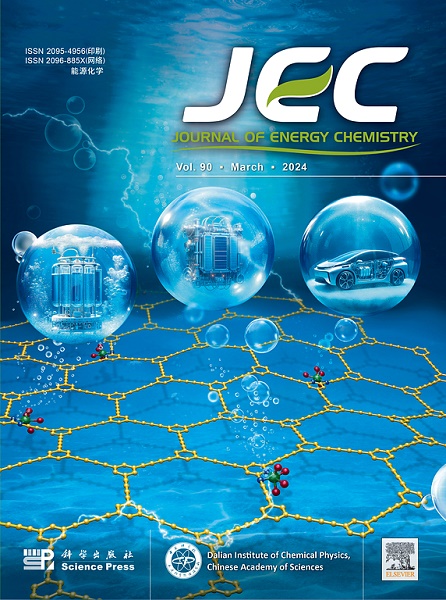Interfacial electron regulation of Fe9Ni9S16/FeS heterostructure confined in N-doped carbon nanotube with enhanced reaction kinetics for efficient Na/Li-Ion storage
IF 13.1
1区 化学
Q1 Energy
引用次数: 0
Abstract
Tailoring 1D nanotubes with refined interfacial interactions and optimized adsorption sites presents a highly promising yet challenging strategy for advancing Na/Li-ion batteries (SIBs/LIBs). Herein, the intertwined yardlong bean-like Fe9Ni9S16/FeS heterostructures with sulfur vacancies encapsulated in N-doped carbon nanotubes (3 N-Fe9Ni9S16/FeS-3@CNTs) are controllably synthesized through Fe/Ni-catalyzed pyrolysis of dicyandiamide followed by sulfidation strategies. 1D nanotubes with robust outer walls and internal cavity structures shorten the diffusion paths of ions/electrons and buffer volume expansion and aggregation of active materials. The Fe9Ni9S16/FeS heterostructure provides a powerful driving force for charge transfer by forming built-in electric fields, optimizing ion adsorption, while the Fe9Ni9S16 features a wider interlayer spacing that allows for frequent Na+/Li+ insertion and extraction, thereby enhancing the reaction kinetics within the electrode. Driven by these synergistic factors, the 3 N-Fe9Ni9S16/FeS-3@CNTs demonstrates remarkable electrochemical performance, achieving a substantial reversible capacity of up to 682.1mA h g−1 for SIBs at 0.1 A g−1 and 782.7 mA h g−1 for LIBs at 0.5 A g−1, alongside exceptional cycling stability in SIBs, maintaining 78.7% of its capacity after 1500 cycles at 1 A g−1 coupling with the ether-based electrolyte. Employing various electrochemical analyses in conjunction with ex-situ characterization techniques and Density Functional Theory (DFT) calculations, the storage mechanisms and phase transition processes are investigated, elucidating the structure-composition-performance relationships. This work paves the way for a new strategy in designing advanced materials with engineered heterostructures and controllable defects for energy conversion and storage devices.
氮掺杂碳纳米管中Fe9Ni9S16/FeS异质结构的界面电子调控及增强反应动力学以实现Na/Li-Ion的高效存储
定制具有精细界面相互作用和优化吸附位点的1D纳米管为推进Na/ li离子电池(sib / lib)提供了一个非常有前途但具有挑战性的策略。本文通过Fe/ ni催化双氰胺热解,然后采用硫化策略,在n掺杂碳纳米管(3 N-Fe9Ni9S16/FeS-3@CNTs)中包裹了具有硫空位的交织一码长的Fe9Ni9S16/FeS异质结构。一维纳米管具有坚固的外壁和内腔结构,缩短了离子/电子的扩散路径,缓冲了活性物质的体积膨胀和聚集。Fe9Ni9S16/FeS异质结构通过形成内置电场,为电荷转移提供了强大的驱动力,优化了离子吸附,而Fe9Ni9S16具有更宽的层间距,允许频繁的Na+/Li+插入和提取,从而提高了电极内的反应动力学。在这些协同因素的驱动下,3n - fe9ni9s16 /FeS-3@CNTs表现出了卓越的电化学性能,在0.1 a g - 1和0.5 a g - 1条件下,sib的可逆容量高达682.1mA h g - 1,在0.5 a g - 1条件下,lib的可逆容量为782.7 mA h g - 1,并且sib具有出色的循环稳定性,在与醚基电解质耦合的1 a g - 1条件下,在1500次循环后仍保持78.7%的容量。采用各种电化学分析,结合非原位表征技术和密度泛函理论(DFT)计算,研究了存储机制和相变过程,阐明了结构-组成-性能之间的关系。这项工作为设计具有工程化异质结构和可控缺陷的先进材料用于能量转换和存储设备铺平了道路。
本文章由计算机程序翻译,如有差异,请以英文原文为准。
求助全文
约1分钟内获得全文
求助全文
来源期刊

Journal of Energy Chemistry
CHEMISTRY, APPLIED-CHEMISTRY, PHYSICAL
CiteScore
19.10
自引率
8.40%
发文量
3631
审稿时长
15 days
期刊介绍:
The Journal of Energy Chemistry, the official publication of Science Press and the Dalian Institute of Chemical Physics, Chinese Academy of Sciences, serves as a platform for reporting creative research and innovative applications in energy chemistry. It mainly reports on creative researches and innovative applications of chemical conversions of fossil energy, carbon dioxide, electrochemical energy and hydrogen energy, as well as the conversions of biomass and solar energy related with chemical issues to promote academic exchanges in the field of energy chemistry and to accelerate the exploration, research and development of energy science and technologies.
This journal focuses on original research papers covering various topics within energy chemistry worldwide, including:
Optimized utilization of fossil energy
Hydrogen energy
Conversion and storage of electrochemical energy
Capture, storage, and chemical conversion of carbon dioxide
Materials and nanotechnologies for energy conversion and storage
Chemistry in biomass conversion
Chemistry in the utilization of solar energy
 求助内容:
求助内容: 应助结果提醒方式:
应助结果提醒方式:


